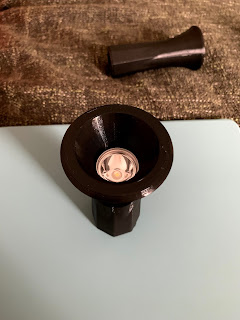Week Seven/Eight: Nightlight
Concept
For this assignment I had a lot of loose concepts floating around and settled on a simplistic, yet functional nightlight. I envisioned a product that can be used, played with, and thrown around by younger kids overcoming scotophobia (fear of the dark), using it for exploration, reading under the sheets, etc..
I wanted to create a flashlight with different materials that looked as if it came from one fluid piece of geometry, one end curvilinear and the other edged and angled. My challenge was making it look like the two different halves translated into a satisfying form.
For this assignment I had a lot of loose concepts floating around and settled on a simplistic, yet functional nightlight. I envisioned a product that can be used, played with, and thrown around by younger kids overcoming scotophobia (fear of the dark), using it for exploration, reading under the sheets, etc..
I wanted to create a flashlight with different materials that looked as if it came from one fluid piece of geometry, one end curvilinear and the other edged and angled. My challenge was making it look like the two different halves translated into a satisfying form.
I wanted to create a flashlight with different materials that looked as if it came from one fluid piece of geometry, one end curvilinear and the other edged and angled. My challenge was making it look like the two different halves translated into a satisfying form.
Process
The basic structure is a revolved custom polyline. The initial polyline fans out like a trumpet, with a convex identation (made from a BooleanDifference with a sphere), designed to shape the light in an interesting way when used. Additionally, another indentation on the body/handle acts as a an ergonomic finger rest, faux-button, or fidget space while users hold the flashlight.
I applied various different filleted edges to round out the toy and make more enthusiastic, approachable form suited to the Gestalt appeal of kids processing shapes and form.
Naked edges
Layers
The basic structure is a revolved custom polyline. The initial polyline fans out like a trumpet, with a convex identation (made from a BooleanDifference with a sphere), designed to shape the light in an interesting way when used. Additionally, another indentation on the body/handle acts as a an ergonomic finger rest, faux-button, or fidget space while users hold the flashlight.
I applied various different filleted edges to round out the toy and make more enthusiastic, approachable form suited to the Gestalt appeal of kids processing shapes and form.
I applied various different filleted edges to round out the toy and make more enthusiastic, approachable form suited to the Gestalt appeal of kids processing shapes and form.
Materials
The main body is composed of soft plastic, with a hint of translucency and roughness to approximate a robust children's toy. The grip components are made from a semiclear plastic with roughness and cloudiness to create a bodied silicone with visual interest within the material. It also adds a cosmic/lunar quality that contributes to the theme of the product. Ultimately, I wanted to ensure the seemless transition between two opposing materials for the sake of contrast and usability. For KeyShot, I created a solid cylinder housed within the body with a 700 lumen LED material applied for the light.
Week Fifteen/Sixteen: Update and 3D Prints
A few weeks back, I printed the nightlight with 3Dallas Printing. The print came out fine, but there was not enough wiggle room to accommodate the flashlight. I attempted to sand it down, but because of the cylindrical tube shape, it was hard to get a reasonable and even sand. I went for another round of printing after using a 2D scale on my model, leaving somewhere around .02" of wiggle room. One down-side of this I didn't realize until after printing is the thickness and weight of this alteration. If I could do another print, I would probably explode the model, find a way to increase the diameter of the interior casing, and make sure my print walls (at their thinnest) remained the same as the previous print, instead of just scaling everything.
 |
| Print one (left) and the new print (right) |
That being said, the new dimensions worked really well, with the light slipping right in with just a smidge of wiggle room. To keep it contained, I just used three layers of regular old Scotch tape, which was all I had, with the last layer taped backwards so the adhesive side faced the print.
Overall, I'm really happy with the outcome and the ability to take this form and actually gauge it's feel in the hand. I was also excited to see how the inverted-dome shape was going to effect the projection of the light.











No comments:
Post a Comment